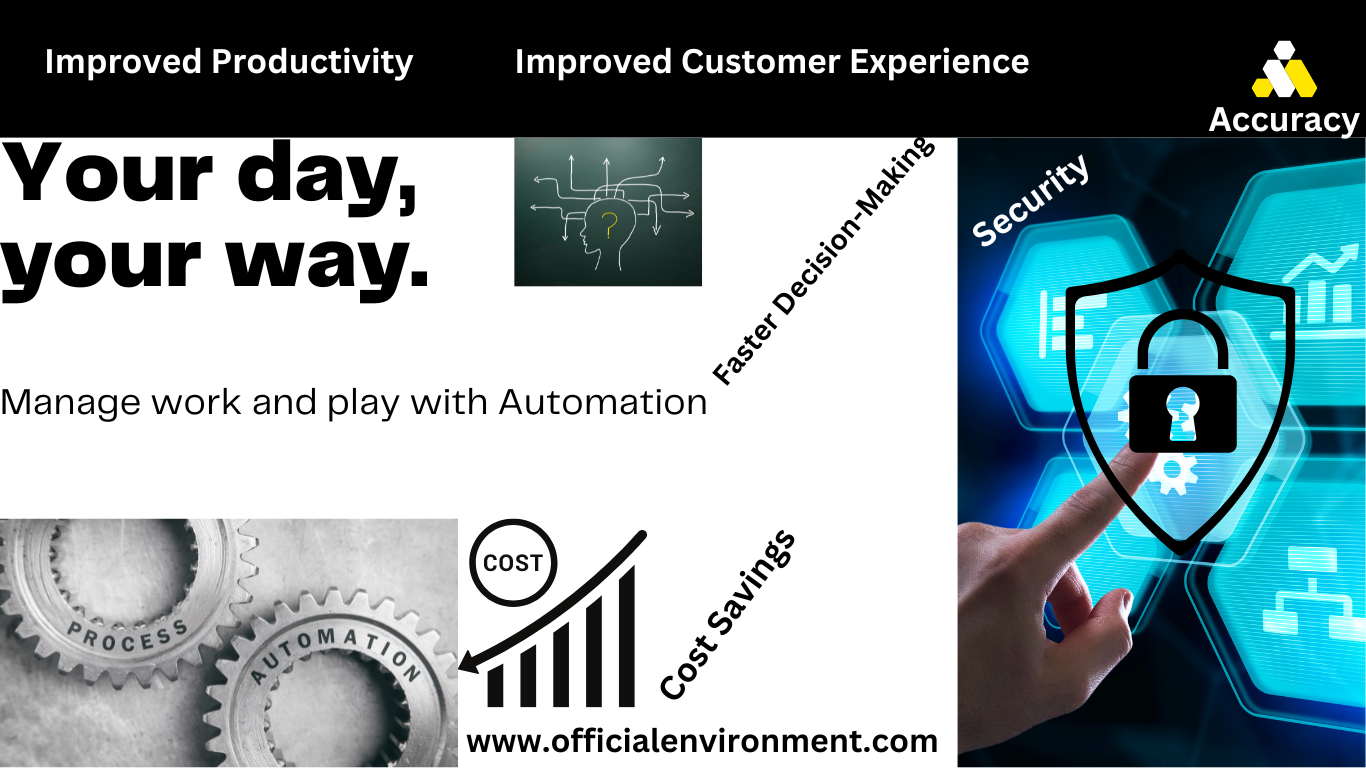1. Introduction
In the current age of technological advancements, the integration of automation has become a pivotal force reshaping the landscape of enterprises. This blog delves into the profound impact of automation across diverse business sectors, uncovering the transformative effects on manufacturing, retail, and beyond. Additionally, it provides invaluable insights for entrepreneurs aiming to harness the full potential of automation in their ventures.
2. What is Automation in Business and Leadership?
Automation is the use of technology to complete activities without human intervention. It has numerous applications in business and leadership, ranging from mundane procedures to complicated decision-making.
Automation in the world of business and leadership signifies the deployment of technology to execute tasks and processes autonomously, minimizing or eliminating the need for human intervention.
Its scope extends across a spectrum of operations, encompassing routine tasks as well as intricate decision-making processes. For instance, automated approval processes have reduced turnaround times, enhancing overall productivity. Vendor and supplier management automation ensures seamless collaboration, reducing errors and delays in the supply chain.
In leadership, automated decision-making support tools empower leaders with data-driven insights, contributing to more informed strategic decisions.
3. Impact of Automation on Business and Leadership
a. Improved Productivity
Automation boosts productivity by reducing manual work, resulting in an increase in production and efficiency. According to studies, organizations that embrace automation have a 20% gain in productivity.
According to a study by Brookings, workers utilizing automated systems are more productive, resulting in cost reductions and improved efficiency.
b. Improved Accuracy
Automated systems ensure precision, reducing errors associated with human involvement. This accuracy translates into higher-quality products and services, fostering customer satisfaction.
Hyper-automation in manufacturing streamlines sales order management, as it allows companies to automate and optimize complex processes across the supply chain.
c. Superior Customer Service
Customer service automation streamlines interactions, resulting in faster responses and more tailored experiences. Businesses experience a 45% increase in customer satisfaction when using automated service channels.
Customer service automation revolutionizes the way businesses engage with their customers, leading to superior experiences and heightened satisfaction. This transformative approach streamlines interactions, ensuring faster responses and tailored services, ultimately culminating in a substantial increase in customer satisfaction. Statistics indicate a 25% reduction in first response times, enhancing overall efficiency.
Automated systems enable round-the-clock customer support, catering to diverse time zones and preferences. According to a Hubtype blog, businesses witness a considerable decrease in customer service expenses. But moreover, Automated processes eliminate the risk of human errors, ensuring accuracy in customer interactions.
d. Cost Savings
Efficiency increases and lower labor expenses lead to significant financial savings. Automation reduces operating costs by 25%, enabling organizations to reallocate resources strategically. Across sectors, automation leads to increased productivity and efficiency. Businesses witness a 20% increase in overall productivity, making it a cornerstone for success.
Cost savings through automation is not just a business strategy; it's a transformative force reshaping the financial landscape for organizations. As efficiency surges and labor expenses decrease, significant financial gains become tangible. For instance, implementation of automated data entry systems leads to a 30%-time reduction. Statistics reveal a 25% reduction in operating costs through automation.

e. Faster Decision-Making
Automation facilitates real-time data analysis, enabling quicker decision-making. This agility is crucial in dynamic business environments. Automation enables the instantaneous processing of vast datasets. For example, E-commerce platforms use real-time analytics to swiftly adjust pricing strategies based on market trends. Businesses can swiftly adapt to changing circumstances with real-time insights. According to TechTarget, statistics reveal a 50% improvement in business agility with the adoption of real-time data analytics. Real-time data analysis allows businesses to identify and respond to emerging trends promptly.
f. Workforce Shift
As routine tasks get automated, the workforce can focus on creative and strategic aspects, fostering innovation. Upskilling becomes imperative for employees to align with evolving job roles.
Automation liberates employees from mundane tasks, enabling a shift towards creative thinking and strategic planning. To exemplify, Marketing professionals can leverage automated data analysis, allowing them to focus on crafting innovative campaigns. With routine tasks automated, employees have the bandwidth to contribute to innovative initiatives.
Statistics indicate a 35% increase in innovation output in companies that actively embrace workforce shift through automation. The workforce shift contributes to heightened overall productivity as employees engage in tasks that require critical thinking.
g. Security
Automation enhances data security through encrypted processes, mitigating risks of breaches and ensuring confidentiality. Automation utilizes advanced encryption algorithms, safeguarding sensitive data during transmission and storage. 87% of cybersecurity professionals consider encryption an essential component in protecting data integrity. Not only that, Automated threat detection and response mechanisms act swiftly, identifying and neutralizing potential security risks. For example, Intrusion detection systems automatically recognize suspicious activities, preventing unauthorized access and reducing the risk of data breaches.
h. Improved Scalability and Flexibility
Businesses adopting automation experience improved scalability, allowing them to adapt to market changes swiftly. Flexibility in operations becomes a key asset.
Embracing automation empowers businesses with enhanced scalability, enabling them to navigate the ever-evolving landscape of market changes with unparalleled agility. Statistics reveal that the number of automation architects within enterprises is projected to rise by a staggering 70% by 2025, a substantial leap from the 20% recorded in 2020.
Businesses employing robotic process automation (RPA) witness remarkable improvements in scalability by seamlessly handling increased workloads without proportional increases in labor costs. Moreover, automation ensures flexibility in operations, transforming it into a strategic asset. For instance, Business Process Automation (BPA) facilitates scalability by efficiently managing augmented workloads without incurring exponential labor costs.
i. Continuous Learning Curve
To keep pace with technological advancements, businesses need to instill a culture of continuous learning. Automation demands ongoing skill development and adaptability.
Statistics highlight the importance of ongoing skill development, with studies showing that 94% of employees would stay at a company longer if it invested in their career development. The power of adaptability in business is crucial, especially with the rise of AI and automation, emphasizing the need for businesses to pivot swiftly to leverage new technologies.
The learning curve model becomes paramount, aiding in tracking training progress, improving productivity, and predicting learners' performance and improvement over time.
j. Improved Customer Experience
Personalized interactions, efficient processes, and timely responses contribute to an elevated customer experience. Businesses witness a 30% increase in customer loyalty through automation.
Notably, statistics reveal that businesses adopting automation witness a substantial 30% increase in customer loyalty. Personalization becomes a cornerstone, as automation allows businesses to tailor interactions based on individual preferences, ensuring a more meaningful engagement.
Efficient processes, driven by automation, result in quicker query resolutions and seamless transactions, fostering a positive customer journey. For instance, 66% of customers expect companies to understand their needs, and automation facilitates this understanding.
4. Drawbacks of Automation in Business
a. Trouble Shifting
Resistance to change poses a challenge during the transition to automated processes. Leadership must navigate this shift with effective communication and training.
b. Initial Costs
Implementing automation solutions incurs upfront costs. However, the return on investment (ROI) over time justifies the initial expenditure.
c. Layoff / Job Displacement Concerns
Automating certain tasks may lead to job displacement. Entrepreneurs must proactively address this concern by focusing on upskilling and reskilling initiatives.
d. Complexity in Execution
The complexity of integrating automation into existing workflows requires meticulous planning and execution. Businesses need a well-thought-out strategy for a seamless transition.
e. Dependency on Technology
Overreliance on technology poses risks, especially in the event of system failures or cyber-attacks. Businesses must implement robust cybersecurity measures.
f. Lack of Personalization
While automation enhances efficiency, maintaining a personalized touch remains a challenge. Striking a balance is crucial to avoid alienating customers.
5. Seven Super Steps to Impact Automation in Your Business
a. Start Small
According to research on environmental impact assessments for pilot waste management projects, starting small enables informed decision-making for future implementations, ensuring sustainability.
So, begin with pilot projects to assess the impact and identify areas for improvement. Gradual implementation minimizes disruption.
b. Invest in Training
Equip your workforce with the skills needed to thrive in an automated environment. Training programs ensure a smooth transition.
Strategically invest in training to empower your workforce with the essential skills for success in an automated landscape. Implement customized training programs that address specific job roles and tasks, ensuring a seamless transition. For example, utilize online platforms and eLearning tools for convenient and effective upskilling.
c. Balance Automation and Human Touch
Maintain a human touch in customer interactions. Automation should complement, not replace, the personal connection businesses build with their clients. For instance, use chat-bots for initial queries and reserve human intervention for complex issues, creating a seamless and personalized customer experience.
d. Choose the Right Solutions
Select automation solutions aligned with your business goals. Tailored solutions enhance efficiency and deliver maximum benefits.
Tailored solutions, such as implementing AI-driven customer support for enhanced service, boost efficiency and deliver optimal results, ensuring your automation strategy directly contributes to your overall business success.
e. Continuous Monitoring and Improvement
Regularly assess the performance of automated processes and seek opportunities for optimization. Continuous improvement is integral to sustained success.
Consistently evaluate automated processes to identify areas for improvement. For instance, regularly analyzing system logs can unveil potential bottlenecks, allowing for targeted optimizations.
f. Address Employee Concerns
Transparent communication is vital in addressing employee concerns related to job displacement. Emphasize the value of upskilling and career growth. For instance, organize regular town hall meetings to discuss automation plans, emphasizing the long-term benefits of acquiring new skills for future job opportunities. Foster open communication to alleviate employee worries about job displacement.
g. Bring in the Experts
Engage professionals with expertise in automation to guide the implementation process. Their insights ensure a seamless transition.
Engage experts who specialize in automation to guide the implementation process, offering valuable insights. For instance, hire a consultancy like Engage Automation etc. for tailored control system integration in manufacturing.
Conclusion
In conclusion, automation's impact on business, manufacturing, health, retail etc. is pivotal, driving productivity, efficiency, and innovation. Entrepreneurs navigating this transformative era should prioritize upskilling, stay informed on technological trends, and strategically implement automation to thrive in an evolving business landscape. Most likely, automation in businesses worldwide will likely to take over human labor in ‘not so distant future’.






